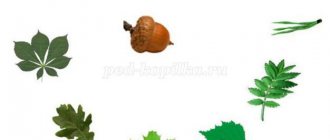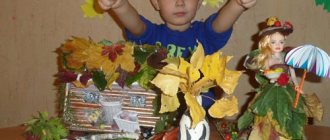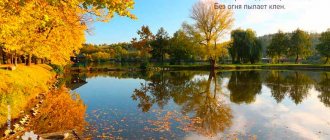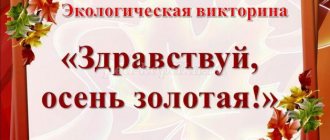MBDOU "Kindergarten No. 5 "Antoshka".
Summary of a group combined lesson in the preparatory group Theme “Gifts of Autumn”
Teacher - speech therapist Chernikova E.G.
2016 Theme “Gifts of Autumn” Goal: development of speech skills, consolidation of knowledge about vegetables and other gifts of nature Objectives: 1. Correctional and educational tasks: • consolidate children’s ideas about changes in nature in autumn • generalize and systematize ideas about vegetables
2. Correctional and developmental tasks: • Encourage children to answer questions, pronouncing words clearly. • Expand the active vocabulary, activate the names of vegetables in children’s speech. • learn to form the diminutive form of nouns and the plural of nouns. • develop the ability to form possessive adjectives. • develop figurative and spatial thinking and imagination and imagination of children. • work on clarity of diction, intonation expressiveness of speech • Develop fine general and fine motor skills of the hands;
3. Correctional and educational tasks: • - to cultivate a sense of self-control and speech regulation; • — develop the ability to listen to the speech of a speech therapist; • — to form a positive emotional state of the child
Methods and techniques: riddles, problematic task, didactic games on the topic of the lesson. Equipment: dummies of vegetables, object pictures “Vegetables”, 2 baskets, a ball. Presentation. Progress of the lesson 1. Speech therapist: Guys, look how many guests we have today. Let us give them smiles and our greetings. Hello, dear guests!
"A moment of friendship." Speech therapist: Now let’s stand in a circle (children stand in a circle, holding hands.) Here’s your palm, here’s your palm. Be friends with me a little. We are friendly guys, friendly, obedient. We smiled at each other and plunged into work.
2. Speech therapist: Guys, every time of the year pleases us with something special, unique. Now I’ll tell you a riddle about the time of year, and you’ll try to solve it. Came without paints. And, without a brush. And repainted all the leaves. (Autumn)
Guys, we received a letter from autumn. What's in the letter? (picture) Let's look at it. (slide 1) 3. Game “Tell about autumn” Showing pictures will signify autumn. The speech therapist asks the children to answer questions. (slide 2) - What are the leaves on the trees in autumn? (yellow, red) - What kind of trees are they in autumn? (sad, colorful) - What is grass like in the fall? (dry, brown, yellow) - What kind of sky? (clear or gloomy) - What clouds? (gray, large) - How does it rain in the fall? (torrential, cold) - What autumn (beautiful, sad). 4. “YES or NO game” - I will read the questions, if the answer is “yes”, I must clap my hands, and if the answer is “no”, I must stomp my feet. Do flowers bloom in autumn? Do mushrooms grow in autumn? Are the clouds covering the sun? The prickly wind is coming? Are there frosts in the fall? Well, do birds build nests? Do the bugs fly? Do animals close their holes? Is everyone getting the harvest? Are flocks of birds flying away? Does it rain often? Is the sun shining very hot? Can children sunbathe? Well, what should you do - put on jackets, hats? What do we collect in the fall? (harvest). What's the harvest? (vegetables, fruits, mushrooms) Where do vegetables grow? (slide 4) Today we will go for a walk and visit the garden, see what grows there. (onions, carrots, radishes, tomatoes, cucumbers). What do they grow on? (in the beds). Conversation about vegetables and their benefits (remember the names of vegetables, what vitamins they are rich in, why you need to eat vegetables) - Guys, vegetables contain a lot of vitamins, why do you think people need vitamins? — That’s right, children, vitamins strengthen our body so that we don’t get sick. 5. Baskets (Relay Race) Now we will divide into two teams and collect the harvest whoever is faster, but we will take only one vegetable each. And we put them in our baskets. 6. It's time to relax and play with your fingers. Physical exercise. Finger gymnastics “Vegetables” Lariska has two radishes Alyoshka has two potatoes Seryozhka the tomboy has two green cucumbers And Vovka has two carrots And Petka also has two tailed radishes. 7. Prepare your palms, I will give you scattered sounds, and you will collect them into words: s-s-s-v-e-k-l-a / beet / l-l-u-k / onion/, etc. d.\ 8.Make a word from the first sounds of words: (slide 5) Beets, dill, tomato. /soup/. 9. What can you cook from vegetables? (salad, juice, soup) (slide 6 - 10) Cabbage salad - cabbage. Tomato salad – tomato. Beet salad - beet salad. Cucumber salad – cucumber. And what will a salad made from different vegetables be called – vegetable. 10.D/I “WHAT HAS CHANGED?” (slide 11 - 12) Memorizing the location of a row of vegetables. 10. Game “Big - small” (with a ball) We have harvested. But different vegetables, both large and small, grew in the beds. (slide 13 - 20) Large pepper and small pepper. Cabbage - cabbage Cucumber - cucumber Tomato - tomato Onion - garlic Peas - peas Potatoes - potatoes Radish - radish 11. Guys, are the vegetables the same color? (No). That's right, vegetables are all different colors. But Buratino just can’t cope with the task, let’s help him. In the picture, the artist painted fruits and vegetables and forgot to color them. You will circle the vegetables and color them. 12. Summarizing the material studied and summing up the lesson.
Summary of OD in the senior group on the topic: “Gifts of Autumn”
Abstract of the educational activity in the compensatory group on the topic: “Gifts of Autumn”
Integration of educational areas: social-communicative, cognitive, speech, artistic and aesthetic development. Goal: creating conditions conducive to sensorimotor development and expanding ideas about the world around us. Objectives: Educational:
To introduce children to an unconventional drawing technique - colored sand.
Teach children to create drawings using a new drawing technique - sand. Developmental:
Develop cognitive activity, coherent speech, fine motor skills.
To consolidate knowledge about vegetables and fruits, the ability to recognize them by their characteristic features. Strengthen the ability to classify objects: fruits and vegetables. Educational:
To develop the ability to cooperate with other children.
Form of organization of children: group Methods and techniques: Visual:
demonstration of visual aids (slides, dummies), demonstration of methods of action.
Verbal
: artistic expression (poems, riddles), conversation, explanation.
Gaming:
didactic game, logorhythmic game.
Practical: productive activities. Preliminary work: conversation about vegetables and fruits;
viewing the album “Gifts of Autumn”; d/games “Wonderful bag”, “Fourth odd”; reading and memorizing poems about autumn; logorhythmic exercises “Shchi-talochka”, “Cook compote”, “Orange”; productive activities (modeling, drawing vegetables and fruits). Equipment:
TSO (laptop, interactive whiteboard), dummies of vegetables and fruits, autumn costume, stencils, colored decorative sand, glue, brushes, oilcloths, scissors, colored paper, wet wipes.
PROGRESS OF EDUCATIONAL ACTIVITIES
1. Organizational moment, the beginning of educational activities.
Goal: Creating positive emotional attitudes towards joint activities and perception of educational material.
Children enter the group, stand in a circle, holding hands, greet each other: Stand in a circle, children. I am your friend and you are my friend. Let's hold hands together and smile at each other. 2. The main part of educational activities.
Goal: Updating the knowledge previously acquired by children about vegetables and fruits. Surprise moment: there is a knock on the door. -Who came to us? Let's get a look. The group includes a girl in an autumn costume with a basket in her hands. — Autumn has come to visit us. The child reads a poem: - Hello, autumn! How are you? How long have you come to us? We will ask you autumn: What did you bring with you? Autumn: Red beads for rowan, Pink apron for aspen, Yellow umbrella for poplars, A rich harvest for you! - This is what a rich harvest autumn has brought for us. She also brought us riddles, let's guess them. Riddles: 1. The red nose has grown into the ground, But the green tail is not needed - It crawled out of the ground. 2. How riddles grew in our garden bed: Juicy and large, So round. They turn green in summer, and turn red in autumn. 3. It’s not at all difficult to guess, everyone can guess! The leaf is elastic, emerald green and curls into the head. 4. Never offended anyone in the world, But still both adults and children cry because of him. 5. Both green and thick A bush grew in the garden bed. Dig a little: Under the bush... Children guess riddles, pictures appear on the slide - answers. - Look at the pictures again, what is this? — What other vegetables do you know? —Where do vegetables grow? — What can you cook from vegetables? Finger game "Vegetables". The hostess once came from the market, (we walk our fingers on the table) The hostess from the market brought home: (clap our hands) Potatoes, cabbage, carrots, peas, (we bend the fingers on our left hand one by one) Parsley and beets, oh! (clap our hands) Covered with a lid, in a stuffy pot (we collect the right palm with a “ladle”, cover the left one on top like a lid) Boiled, boiled in boiling water: (twist the hands in front of us) Potatoes, cabbage, carrots, peas (we bend our fingers one by one) on the hand) Parsley and beets, oh! (clap our hands) And the vegetable soup turned out to be quite good! (show thumb) D/game “Wonderful Bag” - Autumn has prepared another surprise for us - a fun game. I have vegetables collected in a bag; I need to recognize the vegetable without looking (by touch). — They harvest vegetables in the garden in the fall, but what do they collect in the garden? - Let's go to the garden with you. Logorhythmic exercise “Let’s go to the garden” Today we will go to the garden, (we walk in place) We will find different fruits. 1,2,3,4,5 – (clap our hands) We will pick fruits: (imitate picking fruits) Pears, apples and plums, Grapes and oranges We will pick from the tree, Treat everyone we know. (hands forward with a ladle) - We collected a lot of fruits in the garden, but suddenly they got mixed up with vegetables, can you help me sort them? You need to select all the fruits and put them on a plate. - Well done! You have coped very well with all the tasks that autumn has prepared for us. And now I suggest you draw fruits and vegetables. But we will draw not with paints or pencils, but with colored sand. The teacher introduces children to an unconventional drawing technique - sand. Practical work. Children draw vegetables and fruits (of their choice) with decorative colored sand.
The teacher hangs children's drawings on a magnetic board. 3. The final part of the educational activity:
Goal : Assessing the degree of achievement of the set goals for mastering the educational content. Children come up to the magnetic board and look at the pictures. - These are the beautiful drawings we got. Well done guys, you did a very good job. Name the vegetables and fruits you drew.
We recommend watching:
Speech therapy lesson in the senior group on the topic: Autumn Lesson summary - excursions in the senior group of kindergarten. Journey to the autumn forest Educational activities in the senior group on the lexical topic “Autumn. Trees" Summary of a modeling lesson in the senior group of a preschool educational institution on the topic: Autumn
Similar articles:
Summary of a lesson in the senior group on an autumn theme based on the fairy tale “Apple” by V. Suteev
Summary of a lesson in the senior group on the topic “Harvest, vegetables, fruits”





